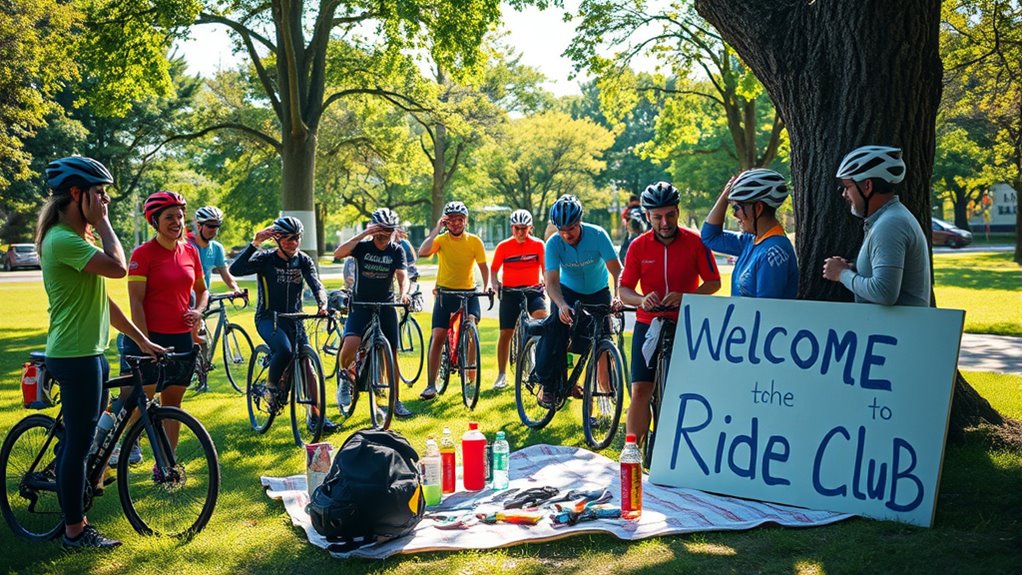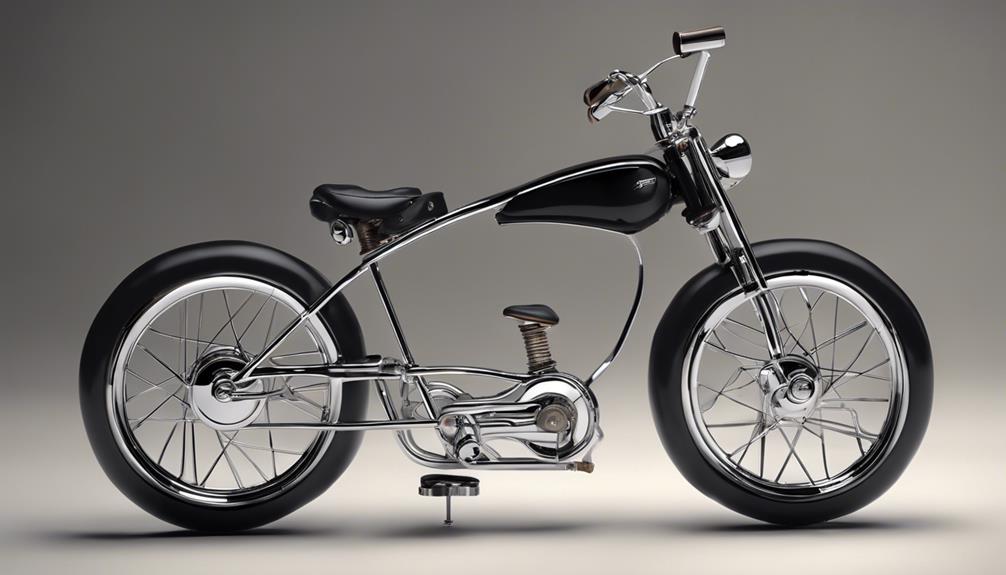If you’re passionate about cycling and community, starting a local ride club is a great idea! Begin by defining your club’s purpose and target audience. Establish leadership roles and set up clear membership guidelines. Organize regular rides for different skill levels and create a welcoming atmosphere. Utilize social media to promote your club and engage members. By bringing people together, you foster friendships and encourage healthier lifestyles. Stick around to discover valuable tips for success and growth!
Key Takeaways
- Define your club’s purpose and target audience to attract members who share similar cycling interests.
- Establish leadership roles and clear responsibilities to ensure effective governance and organization.
- Schedule regular group rides catering to various skill levels to foster community and inclusivity.
- Promote the club through social media, local partnerships, and events to reach potential members.
- Collect feedback from members to continuously improve the club experience and strengthen community ties.
Why Should You Start a Bicycle Club
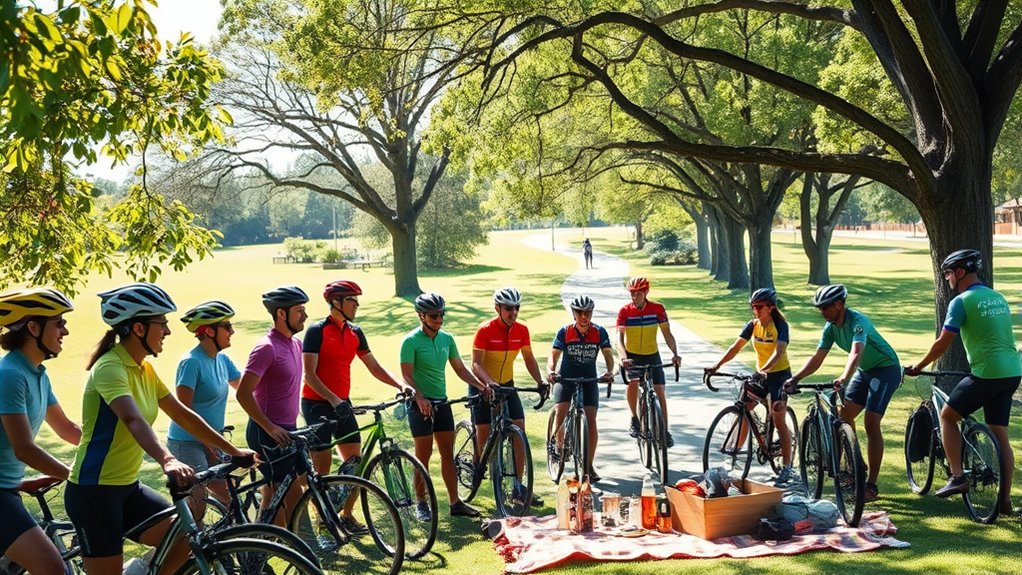
Starting a bicycle club can be a game-changer for both seasoned cyclists and newcomers alike.
You’ll create a supportive community that fosters friendships through regular group rides and social events. With your club, you’ll address local cycling needs, organizing opportunities that cater to various speed and distance preferences, making cycling more inclusive.
Create a welcoming community where friendships thrive through group rides and events, catering to all cycling abilities and preferences.
This structured environment not only promotes fitness but also encourages individuals to adopt healthier lifestyles. By sharing knowledge and skills, experienced members can help newcomers improve their cycling abilities.
Plus, your club can enhance community engagement by organizing charity rides, participating in local events, and advocating for better cycling infrastructure. It’s a fantastic way to connect, ride, and make a difference together. Additionally, your club can benefit from unbeatable savings by leveraging group purchasing options for cycling gear and accessories.
Different Types of Bicycle Clubs
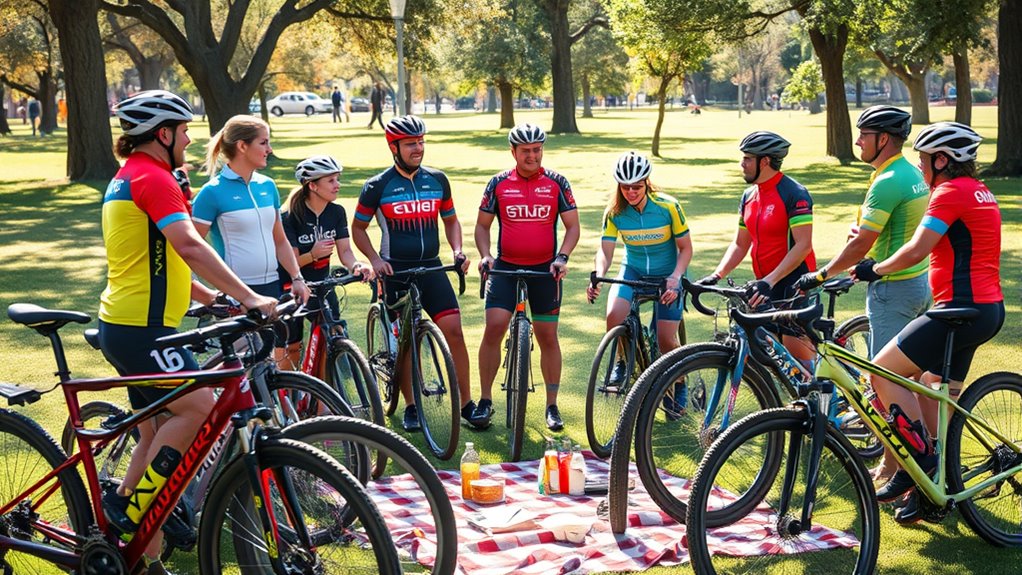
When you’re looking to join a bicycle club, you’ll find a variety of options to contemplate.
Social cycling clubs focus on fun and building community, while competitive cycling clubs offer structured training for those aiming to race. Understanding the differences can help you choose a club that matches your interests and goals. Additionally, many clubs also host cycling adventures and events that can further enhance your riding experience.
Social Cycling Clubs
Social cycling clubs offer a unique way to engage with fellow cyclists while having fun and building community.
These clubs emphasize enjoyment over competition, making them perfect for anyone looking to connect with others. Here are some features that set social cycling clubs apart:
- Rides for all skill levels, from casual to leisurely
- Post-ride events like picnics or gatherings to foster camaraderie
- Collaborations with local businesses, including bike shops and cafés
- A welcoming atmosphere that helps new members feel at ease
- Structured ride guidelines to guarantee everyone enjoys the experience
Joining a social cycling club can enhance your cycling journey and create lasting friendships within your local community. Additionally, participating in such clubs can improve your mental health status by promoting physical activity and social connections.
Competitive Cycling Clubs
While social cycling clubs focus on camaraderie and enjoyment, competitive cycling clubs cater to those with a passion for training and racing.
These clubs organize structured practice sessions and competitions, helping you improve your skill level and achieve racing goals. Competitive cycling clubs often participate in various categories, including road, mountain, and cyclocross, addressing diverse interests within the cycling community.
Membership dues typically cover training facilities, race entry fees, and team apparel, fostering a strong sense of belonging. Additionally, successful clubs emphasize camaraderie through teamwork and shared training experiences, encouraging mentorship among members.
Engaging in local and regional races not only boosts recognition but also attracts new members, solidifying your club’s presence in the cycling community. Moreover, participating in events can lead to enhanced aerodynamics and improved performance, similar to the benefits seen in competitive tuning for vehicles like BMWs.
How to Start a Bicycle Club in 10 Steps

Starting a bicycle club can be an exciting way to bring together cycling enthusiasts and foster a sense of community.
Here’s how to start something impactful:
- Define your club’s purpose and identify your target audience.
- Establish leadership roles and outline responsibilities for effective governance.
- Implement a clear membership structure with dues and benefits.
- Create safety guidelines, including helmet requirements and riding etiquette.
- Use social media and local partnerships to promote your club and plan regular rides.
- Consider incorporating mindfulness practices into your rides to enhance focus and enjoyment.
Best Practices for a Successful Bicycle Club

Building on the excitement of launching a bicycle club, establishing best practices is key to ensuring its long-term success and vibrancy. Start by defining your club’s purpose to attract like-minded members. Schedule regular rides for all skill levels to create a welcoming environment. Enforce safety guidelines, including helmet use and the rules of the road, to prioritize member safety.
Utilize social media and local partnerships to boost visibility, encouraging member referrals. Regularly gather feedback to adapt and improve the club experience. Additionally, consider organizing outdoor events that incorporate activities like camping, which can enhance community bonding.
| Best Practices | Benefits | Tips |
|---|---|---|
| Define club identity | Attract the right members | Be clear and concise |
| Schedule regular rides | Foster community | Cater to all levels |
| Implement safety rules | Minimize risks | Educate all members |
Encourage members to stick around and enjoy the journey!
Engage With the Cycling Community
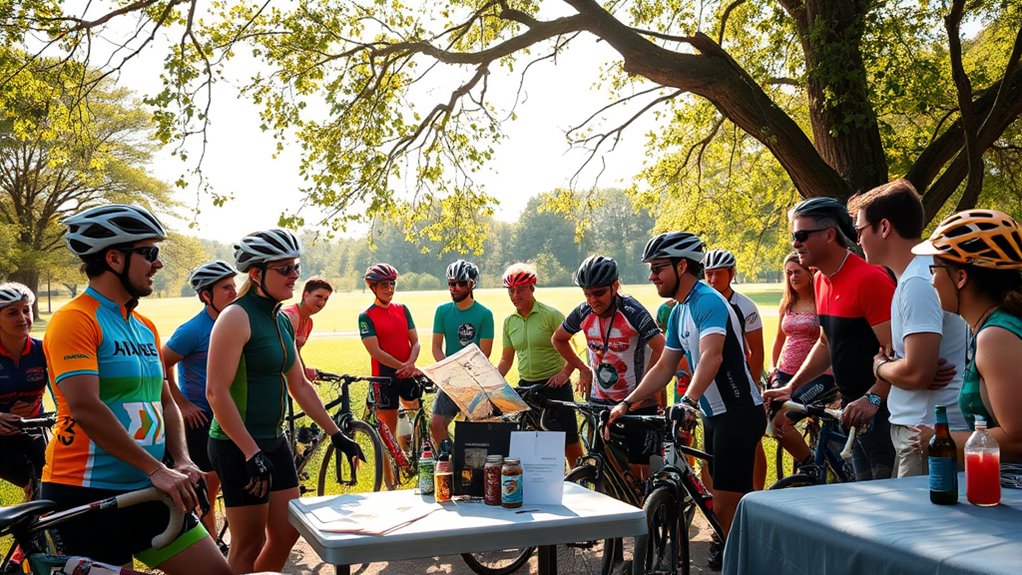
Engaging with the cycling community is essential for creating a vibrant and welcoming atmosphere within your bicycle club. By connecting with others, you’ll foster camaraderie and keep it going.
Here are some good ways to engage:
- Use social media like Facebook and Instagram to announce rides and share good stuff.
- Distribute flyers at local bike shops and cafes to attract casual cyclists trying to find a group.
- Create an event page on Meetup.com to post rides and connect with enthusiasts.
- Partner with local businesses to establish hubs where cyclists can gather.
- Offer a variety of ride options for different skill levels, encouraging inclusivity and conversations.
Additionally, consider organizing themed rides that celebrate cycling with style, as this can draw in more participants and enhance the experience.
Together, these efforts would help strengthen community bonds and make your club thrive!
Utilize Member Management Software

Using member management software can really streamline your club’s operations, making it easier to track dues and manage events. You’ll also automate member communication, ensuring everyone stays informed and engaged. Plus, with tools to track participation metrics, you can gain valuable insights into your club’s growth and member involvement. Additionally, implementing effective budgeting strategies can help ensure your club remains financially sustainable while fostering a strong community spirit.
Streamline Club Operations
To enhance your club’s efficiency, implementing member management software can be a game-changer. This tool helps you streamline operations and communication, saving time for both you and your members.
Here are some key benefits:
- Automates membership registration and dues collection
- Provides a secure online portal for essential documents and event details
- Sends automated email reminders for upcoming rides and events
- Facilitates discussions, polls, and feedback to engage members
- Offers reporting and analytics to track growth and participation
- Regular socialization opportunities can help foster a sense of community among members.
Automate Member Communication
While managing a cycling club can be rewarding, keeping everyone informed and engaged often requires significant effort. To simplify this, consider utilizing member management software. This technology can automate communication by sending reminders for upcoming rides and events, ensuring all members stay in the loop.
Many platforms, like WildApricot, offer customizable email templates, helping maintain consistent branding in your messages. Additionally, automated member registration and payment processing help reduce administrative burdens, allowing you to focus on fostering member engagement.
With tools for targeted communication, you can segment your lists to send specific updates based on skill level or ride interests, enhancing the overall experience and connection within your cycling community. Moreover, leveraging freelance gigs available through social media can attract new members who are interested in joining your rides.
Track Participation Metrics
Automated communication tools can enhance your club’s operations, but they’re just part of the picture.
To truly thrive, you need to track participation metrics effectively. Utilizing member management software helps streamline this process, focusing on:
- Ride attendance and participation rates
- Member engagement statistics
- Feedback collection after rides and events
- Frequency of participation and ride diversity
- Identifying active members for targeted outreach
Frequently Asked Questions
How Do I Open a Cycling Club?
To open a cycling club, start by defining your club’s purpose. Decide if you want social rides or competitive training.
Establish a simple governance structure with key roles to streamline organization.
Create a membership framework that outlines dues and benefits, ensuring clear communication with potential members.
Organize regular rides with set schedules to engage participants.
Finally, promote your club through social media and local events to attract new members and create an inclusive atmosphere.
What Is the 80% Rule in Cycling?
Imagine your heart as a finely tuned engine, revving just right.
The 80% rule in cycling suggests you should keep that engine running at about 80% of your maximum heart rate during training. This balance allows you to build endurance without burning out.
What Is the 75 Rule in Cycling?
The 75 Rule in cycling suggests you aim to keep your heart rate around 75% of your maximum during training.
To find your maximum, just subtract your age from 220. This targeted effort helps improve your endurance and aerobic fitness while balancing training intensity.
Using a heart rate monitor can help you stay in this zone, optimizing your workouts for better performance and stamina during those longer rides or races.
How Do You Organize a Community Bike Ride?
To organize a community bike ride, start by setting a regular schedule, like weekly or bi-weekly.
Clearly communicate the ride details, including meeting times, routes, and pace options, so everyone feels included.
Promote the rides on social media and local boards, encouraging word-of-mouth.
Implement safety guidelines, like wearing helmets and following riding etiquette.
Finally, consider post-ride social gatherings to build camaraderie and strengthen your community of riders.
Conclusion
Starting a bicycle club might feel intimidating, but remember, every great journey begins with a single pedal stroke. Sure, you might worry about not having enough members to make it worthwhile, but think of the friendships and memories you’ll create along the way. Imagine sharing the thrill of a ride with others who share your passion. You’re not just building a club; you’re fostering a community that can inspire and uplift everyone involved. So, grab your bike and start rolling!
